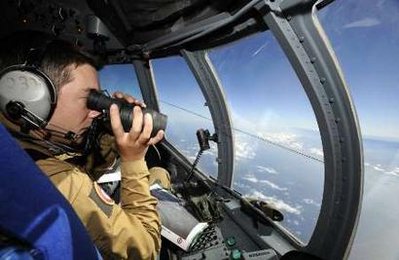Towering Atlantic storms are common this time of year near the equator -- an area known as the intertropical convergence zone. "That's where the northeast trade winds meet the southeast trade winds -- its the meeting place of the southern hemisphere and the northern hemisphere's weather," said Margusity.
But several veteran pilots of big airliners said it was extremely unlikely that Flight 447's crew intended to punch through a killer storm.
|

A crew member uses binoculars, in this photo released on June 2, 2009 by the French Defense Ministry, as a Breguet Atlantique flies a search mission. [Agencies]
|
"Nobody in their right mind would ever go through a thunderstorm," said Tim Meldahl, a captain for a major US airline who has flown internationally for 26 years, including more than 3,000 hours on the same A330 jetliner.
Pilots often work their way through bands of storms, watching for lightning flashing through clouds ahead and maneuvering around them, he said.
"They may have been sitting there thinking we can weave our way through this stuff," Meldahl said. "If they were trying to lace their way in and out of these things, they could have been caught by an updraft."
The same violent weather that might have led to the crash also could impede recovery efforts.
"Anyone who is going there to try to salvage this airplane within the next couple of months will have to deal with these big thunderstorms coming through on an almost daily basis," Margusity said. "You're talking about a monumental salvage effort."
Remotely controlled submersible crafts will have to be used to recover wreckage settling so far beneath the ocean's surface. France dispatched a research ship equipped with unmanned submarines that can explore as deeply as 19,600 feet (6,000 meters).
A US Navy P-3C Orion surveillance plane -- which can fly low over the ocean for 12 hours at a time and has radar and sonar designed to track submarines underwater -- and a French AWACS radar plane are joining the operation.
France also has three military patrol aircraft flying over the central Atlantic, two commercial ships reached the floating debris, and Brazilian navy ships were en route.
Even at great underwater pressure, the black boxes "can survive indefinitely almost. They're very rugged and sophisticated, virtually indestructible," said Bill Voss, president and CEO of the Flight Safety Foundation in Alexandria, Va.
"I would expect they'll dedicate the rather substantial resources of the French navy to this," Voss added. "I've got to figure this will go quickly. I'm hoping they'll have stuff up in a month, if not just a few weeks."

